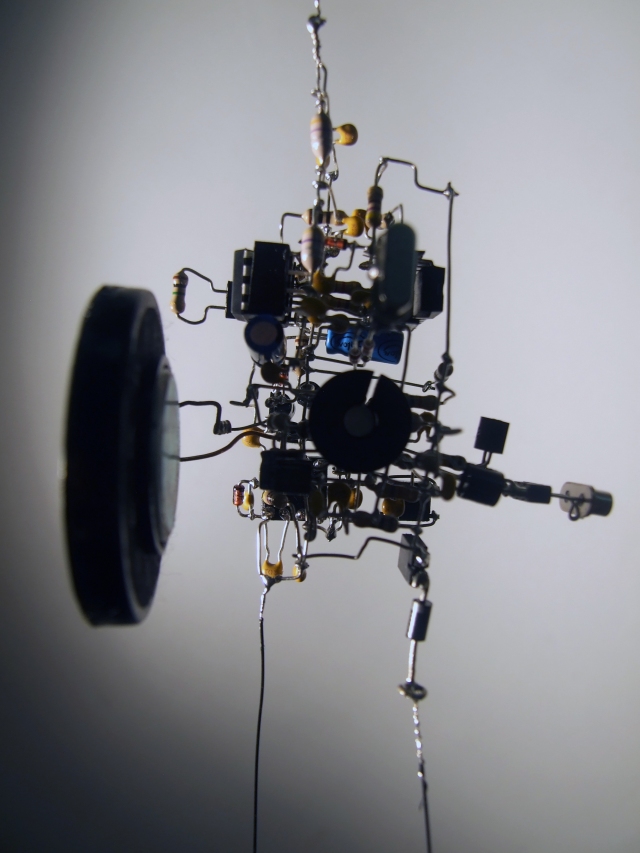Essays in Interstellar Communication, 2019

Politics mired in the culture wars, social isolation brought about by the recent pandemic, and a changing media landscape have emerged alongside a polarization that threatens our collective ability for meaningful, productive dialogue. I wish to engage the public in considering how to move beyond our impasses by visually invoking the mystique of hope and progress that surrounded our first steps into space 50 years ago.
Taking interstellar distance as an analogy for ideological distance, I have created a series of fantastical designs for electro-mechanical communication devices. While they reference rational scientific elements, the visual execution is loose and betrays a sense of the irrational. Thus, our discussion of ideology is overtly contextualized by this push and pull of the rational and irrational and between medium and message.
Through these works, I ask the question: how do we move forward in this media-rich age of division, isolationism, and fear? How can we construct dialogue that embraces hope, recognizes our common humanity, and brings us closer?
Faraday Sheild, 2017

Faraday Shield is an ambiguously humorous attempt to escape the conforming influences of the media and find a uniquely personal worldview based on one’s own experiences. Set on top of a remote mountain, the disheveled protagonist searches for solitude while wrapping himself in tinfoil to keep out the global media, all the while searching the horizon for his own understanding.
Viewpoints, 2016

Viewpoints examines the roll media plays in shaping our understanding of the world. Each video captures a shortwave radio in picturesque landscapes of central Newfoundland. The radio’s staging within the picture plane disconnects it from the landscape while the sound of the natural environment contrast with the broadcasted audio. Varying signal propagation conditions combined with the radio’s unique construction allow for several stations to play simultaneously, re-narrating the constructed world views of the state, religious and commercial broadcasters. In this remote landscape, we are surrounded by global messages that shape our view of the world and dominate our senses. The media is both literally and figuratively in the foreground while the physical reality around us plays only a minor role in our ‘view’ of the world.
Signal & Message, 2014

Messages are an inescapable part of our environment: from billboards and a 24/7 news cycle in urban centers, to shortwave signals reaching the remotest parts of the globe. These messages shape public discourse and provide a context for how we see the world around us. By tightly controlling their use, governments and corporations have been successful in limiting and/or trivializing public discourse on important issues. Signal & Message seeks to expose the physical workings of the medium and deconstruct its messages from within the technology itself. In linguistic terms, I create a type of technological poetry that plays with the grammar of the technology to create extra-linguistic meaning.
The ubiquity of current technology can hide the role it plays in shaping what gets said, who hears it, and ultimately the power structures behind the messages. Since shortwave and passive radios are seen as relics of past technology, parsing message, and medium – to see and question the interplay between signal and message – is an accessible analogy to our current digital mediums.
Unlike modern radio receivers, simple passive receivers allow the listener to get closer to the signal source itself. Several stations can be heard simultaneously drifting in and out of tune, overlapping, intermodulating, and ultimately collapsing the carefully constructed narratives. In real-time, the radio waves weave their own stories – a collage of disparate, sometimes conflicting world views.
The Machine & The Person, 2010-2018

This series of engravings and drypoint prints explores the relationship between the individual and society.
Transmutation, 2008-2013

Transmutation is an ongoing project that questions the value of the digital as an artifact of the digitized. Custom-built software modifies a computer file’s digital envelope, ‘tricking’ the computer into believing the file is another type. The audience thus sees music and hears images – re-categorizing and re-contextualizing the digital signs. The file retains its original meaning while taking on a wholly unrelated emotional and aesthetic experience – a digital poetic.
I’m Not Crazy, 2003

In redefining man’s relationship to labor, the Industrial Revolution sparked a series of paradigm shifts in human’s relationship with ourselves and the world. For the Futurists, the human-centric world gave way to the speed and metal of the machine. Post-WWII pop culture gave us the semi-autonomous machine, the robot, while the introduction of the computer into the average household in the 1980s gave the robot super-human powers. By the turn of the millennium, pop culture’s interpretation of the internet had disembodied this idealized humanoid: we no longer dream of speed or strength, of being part machine. Rather we dream of total emergence: we enter the machine – not to become part of it – but to live surrounded by it. In effect, the machine can exist without us; but our existence depends on it. Meanwhile, the outside world – what would previously have been referred to as ‘reality’ – lies in environmental ruins.
I’m Not Crazy! was a project meant to address this total emergence in the digital. Drawing on the folk-hero man vs machine motif, I spent 6 weeks writing hexadecimal data on a mural as a challenge to the computer and to question the digital as a means of communication. The completed mural remained in place for one day before being painted white.
You must be logged in to post a comment.